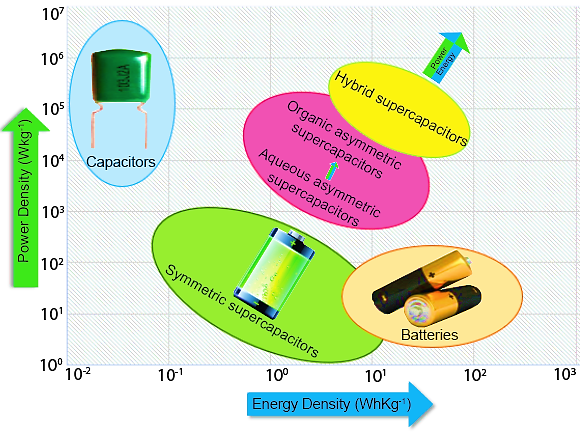Parnia Forouzandeh
Current PhD Student
2D nanomaterials for efficient asymmetric supercapacitors
Research Topic
This research is mainly divided into two primary activities: Preparation and Characterization of novel 2D materials and utilizing these nanostructures for fabricating supercapacitor devices.
The supercapacitor is an emerging technology in energy storage systems that offer higher power density than batteries and higher energy density than traditional capacitors. (Figure 1) The electrode and electrolyte materials have a tremendous effect on the supercapacitor’s performance.
Parnia’s research focuses on synthesizing 2D heterostructures through innovative preparation methods, including the hydrothermal, sonochemical and microwave techniques, and optimizing the electrochemical performance of the assembled supercapacitor device to achieve an advanced power density than existed supercapacitors.

Figure 1. Ragone plot of the power-energy density range for different electrochemical energy storage devices.
Profile:
Parnia obtained a B.Sc. in the “chemical engineering-inorganic chemical industry” and the M.sc degree in “chemical nanoengineering“, which focused on researching energy conversion devices, mainly perovskite solar cells. She has done her M.sc under the European Erasmus Mundus Joint program in three different universities of Aix-Marseille University (France), the Wroclaw University of Science and Technology (Poland), and the University of Rome Tor Vergata (Italy).
The final project of her M.sc has been based on two separate steps, including a) the synthesis, exfoliation of metal-organic frameworks (MOFs) to achieve an optimized Two-dimensional layer double hydroxides (2D-LDHs) and the characterization process using SEM, FTIR, X-Ray techniques, and b) the fabrication of perovskite solar cells using 2D-LDHs. Through this project at the “Centre for Hybrid and Organic Solar Energy (CHOSE), she’s been skilled in all the steps related to the solar cell fabrication process, including the utilization of spray pyrolysis set, spin coater, metal vapour depositor.
Besides her academic background, Parnia spent four years working in the polymer industry after obtaining her B.Sc. in different companies and working as a research assistant in Italnanotech Company (Italy) during her master studies. Her research scope involved working on the non-toxic resins and the carbon allotropes, mainly carbon nanotubes (CNTs), to achieve advanced components with an excellent mechanical performance, which could be used to produce the thermal barriers, exhaust systems, engine parts, and other components that are exposed to high temperatures and strain.
Parnia also recently worked on the face visor production team in IT Sligo and wrote a review paper, and assisted in writing a research paper based on the teams’ work to help fight against COVID-19.
She feels that the encouragement, generous help, and support from her supervisor, “Professor Suresh C. Pillai“, and the research-driven outlook of IT Sligo provide her with many opportunities to learn more and improve her knowledge and research in IT Sligo.
Papers
Published papers:
- Forouzandeh and S. C. Pillai, “Two-dimensional (2D) electrode materials for supercapacitors,” Mater. Today Proc., no. xxxx, Jun. 2020, doi: 10.1016/j.matpr.2020.05.233.
- Forouzandeh, V. Kumaravel, and S. C. Pillai, “Electrode materials for supercapacitors: A review of recent advances,” Catalysts, vol. 10, no. 9, pp. 1–73, Aug. 2020, doi: 10.3390/catal10090969.
- O’Dowd et al., “Face masks and respirators in the fight against the COVID-19 pandemic: A review of current materials, advances and future perspectives,” Materials (Basel)., vol. 13, no. 15, 2020, doi: 10.3390/ma13153363.
- Forouzandeh, K. O’Dowd, and S. C. Pillai, “Face masks and respirators in the fight against the COVID-19 pandemic: An overview of the standards and testing methods,” Saf. Sci., vol. 133, p. 104995, Jan. 2021, doi: 10.1016/j.ssci.2020.104995.
Under submission:
- 2D MoS2-based photocatalysts: Structure, mechanisms, and environmental applications (Review)
Under preparation:
